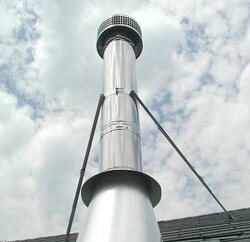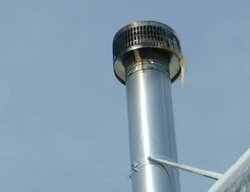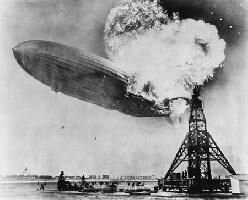With seeing and reading the different threads and posts on chimney caps getting clogged with krap i feel we need to look into some of the issues.
Wile we have some say keep the cap on the chimney and some say to take it off how about we look into the issues of caps and the design.
I am on the side to say on the forum to keep the cap on the pipe BECAUSE i do no want birds and such in the pipe and i also feel that it helps keep out rain and snow from going down the pipe. I also state on this forum to leave the cap on BECAUSE there are so many people burning junk like paper and cardboard in there stove and i feel the chimney cap is going to help keep the burning fly ash in the pipe. Its hard to just say "yeah , just take the cap off" when you know there are people burning paper and such in there stove.
From what i have read on the forums its looks to "me" that the issues of the krap in the chimney cap are on the side of stoves with liners and not so much with double wall stainless steel class A chimney pipe .............but thats what this thread is about. With all the stuff we talk about here one would think we could get to the bottom of the clogged chimney cap issue.
I'll start , If my feeling is true that the issue is mostly chimneys with liners and as i notice the liner sticks out past the chimney 6"-12" i would think is really going to cool off the pipe and collect krap in the top of the pipe and the cap. What if one could take a short section of double wall class A stainless steel 8" pipe to place on top of the chimney were the liner comes out and run the hook togother class A cap pipe to it ? this would hep insulate the top section of the exposed liner to the wind and cold.
Information on different screen sizes , different cap styles ect... all information is welcome. This sounds like and easy fix but i dont feel we have put out thumb on the issue to change the problem.
What-ch got boys and girls? pipes , caps , screens and sizes , insulated or non insulated .....
web link of different class A pipes that could be installed on top of the chimney. Comes in lenghts of 6" , 12" , 1 ,24" , 36" , 48" in sizes of 6" ,7", 8' , 12"
http://servicesales.com/metal-fab/chimney.html
Wile we have some say keep the cap on the chimney and some say to take it off how about we look into the issues of caps and the design.
I am on the side to say on the forum to keep the cap on the pipe BECAUSE i do no want birds and such in the pipe and i also feel that it helps keep out rain and snow from going down the pipe. I also state on this forum to leave the cap on BECAUSE there are so many people burning junk like paper and cardboard in there stove and i feel the chimney cap is going to help keep the burning fly ash in the pipe. Its hard to just say "yeah , just take the cap off" when you know there are people burning paper and such in there stove.
From what i have read on the forums its looks to "me" that the issues of the krap in the chimney cap are on the side of stoves with liners and not so much with double wall stainless steel class A chimney pipe .............but thats what this thread is about. With all the stuff we talk about here one would think we could get to the bottom of the clogged chimney cap issue.
I'll start , If my feeling is true that the issue is mostly chimneys with liners and as i notice the liner sticks out past the chimney 6"-12" i would think is really going to cool off the pipe and collect krap in the top of the pipe and the cap. What if one could take a short section of double wall class A stainless steel 8" pipe to place on top of the chimney were the liner comes out and run the hook togother class A cap pipe to it ? this would hep insulate the top section of the exposed liner to the wind and cold.
Information on different screen sizes , different cap styles ect... all information is welcome. This sounds like and easy fix but i dont feel we have put out thumb on the issue to change the problem.
What-ch got boys and girls? pipes , caps , screens and sizes , insulated or non insulated .....
web link of different class A pipes that could be installed on top of the chimney. Comes in lenghts of 6" , 12" , 1 ,24" , 36" , 48" in sizes of 6" ,7", 8' , 12"
http://servicesales.com/metal-fab/chimney.html






